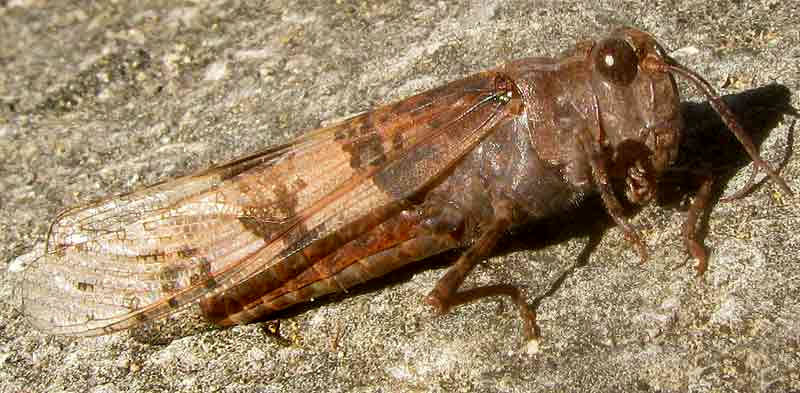The three stages of simple metamorphosis are:
EGG --> NYMPH --> ADULT
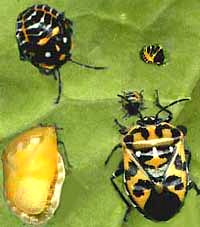
At the right you see a small patch of a leaf of a collard plant suffering from a heavy infestation of Harlequin Bugs, Murgantia histrionica, a kind of stinkbug found in the US Southeast. The two tiny specimens in the picture's top, right quarter are very young Harlequin Bugs recently hatched from their eggs. 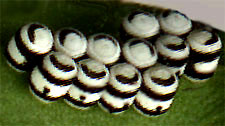 Some Harlequin Bug eggs are shown at the left.
Some Harlequin Bug eggs are shown at the left.
In the picture at the right, a older but still immature Harlequin Bug is seen in the picture's top, left corner. Note that, like the smaller immature bugs, its form and coloration is similar to that of the adult in the adult occupying the picture's lower, right corner. However, both of the immature dark stages lack wings covering their banded abdomens.
The yellow thing in the picture's lower, left corner also is a Harlequin Bug... So, what's going on here?
INSECT ORDERS UNDERGOING SIMPLE METAMORPHOSIS
Ephemeroptera (mayflies)
Odonata (dragonflies)
Orthoptera (grasshoppers)
Blattodea (termites & cockroaches)
Dermaptera (earwigs)
Psocoptera (booklice & barklice)
Mallophaga (chewing lice)
Anoplura (sucking lice)
*Thysanoptera (thrips)
Hemiptera (true bugs)
Homoptera (cicadas, aphids, etc.)
*Thrips metamorphosis is between simple and complex
What's happening is that all the bugs in the picture except the adult in the lower, right corner are nymphs, mentioned above as the middle part of the diagram of simple metamorphosis. The smallest bugs have just emerged from the egg, and the larger, dark nymph has already metamorphosed several times to get as large as it is, but it's not an adult yet. It's like a teenager, almost there.
The yellow one is a brand new adult Harlequin Bug just moments after metamorphosing from its last nymphal stage! After it sits drying and hardening awhile, it will assume the colors and hardness of the adult Harlequin Bug at the lower right.
Insect nymphs do not grow gradually because insects have exoskeletons -- skeletons outside their bodies instead of inside them. As insect nymphs grow, they break through a series of exoskeletons. The various nymphal stages between egg and adult are referred to as instars. The two small bugs at the top, right quarter of the above picture are first-instar Harlequin Bugs, while the bug at the top, left is one of the middle instars.
Below is an ant-size, first-instar grasshopper among the hairs on a human arm.
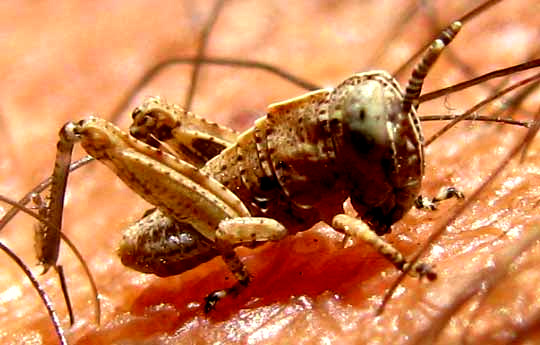
You can see that, like the above immature Harlequin Bugs, it has the general shape of an adult grasshopper, but is much smaller, its head is proportionally larger than the body, and it no wings at all. This recently hatched baby grasshopper will now eat and eat, molt and molt, and with each molt it grow larger, and during latter stages its wings will appear as buds and enlarge. Below is a later-stage nymph grasshopper, probably the 5th instar, showing developing wings.
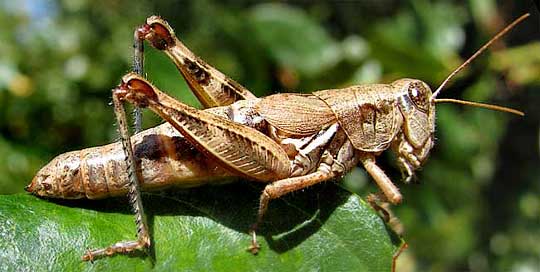
And below is an adult with fully formed wings:
